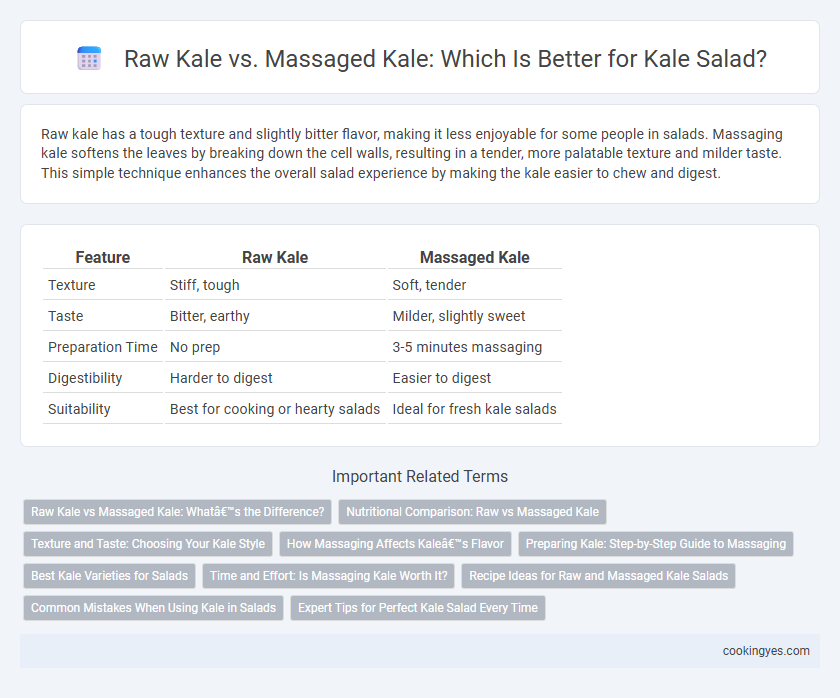Raw kale has a tough texture and slightly bitter flavor, making it less enjoyable for some people in salads. Massaging kale softens the leaves by breaking down the cell walls, resulting in a tender, more palatable texture and milder taste. This simple technique enhances the overall salad experience by making the kale easier to chew and digest.
Table of Comparison
| Feature | Raw Kale | Massaged Kale |
|---|---|---|
| Texture | Stiff, tough | Soft, tender |
| Taste | Bitter, earthy | Milder, slightly sweet |
| Preparation Time | No prep | 3-5 minutes massaging |
| Digestibility | Harder to digest | Easier to digest |
| Suitability | Best for cooking or hearty salads | Ideal for fresh kale salads |
Raw Kale vs Massaged Kale: What’s the Difference?
Raw kale in salads retains a firm texture and slightly bitter taste, offering maximum fiber and nutrient density such as vitamin K and antioxidants. Massaged kale, softened by rubbing with oil or lemon juice, breaks down tough fibers, enhances digestibility, and reduces bitterness, resulting in a tender, more palatable leaf. Nutrient bioavailability may improve slightly with massaging, while raw kale preserves a crisper, more robust flavor profile.
Nutritional Comparison: Raw vs Massaged Kale
Raw kale retains higher levels of vitamin C and antioxidants but can be tougher and more difficult to digest. Massaged kale softens the leaves by breaking down fibrous cell walls, increasing bioavailability of beta-carotene and facilitating nutrient absorption. Both forms offer significant amounts of vitamin K, calcium, and fiber, with massaged kale providing a more palatable texture for salad consumption.
Texture and Taste: Choosing Your Kale Style
Raw kale offers a robust, slightly bitter flavor with a firm, chewy texture that provides a hearty bite in salads. Massaged kale transforms the leaves into a tender, milder component by breaking down fibers, resulting in softer texture and enhanced sweetness. Selecting between raw and massaged kale depends on desired salad mouthfeel and flavor intensity, with massaged kale preferred for smoother, more palatable dishes.
How Massaging Affects Kale’s Flavor
Massaging kale breaks down its fibrous cell walls, transforming the texture from tough and bitter to tender and palatable. This process releases natural enzymes that mellow kale's bitterness and enhance its sweetness, making it more flavorful for salads. Raw kale retains a robust, slightly bitter taste and a chewy texture, which can overpower delicate dressings and other ingredients.
Preparing Kale: Step-by-Step Guide to Massaging
Massaging kale breaks down its tough fibers, making the leaves softer and easier to chew compared to raw kale. Using your hands, gently squeeze and rub the kale with a small amount of olive oil and lemon juice for about 3-5 minutes until the leaves darken and become tender. This simple preparation enhances the flavor and digestibility of kale, creating a more enjoyable salad experience.
Best Kale Varieties for Salads
Raw kale varieties such as Lacinato and Red Russian offer a robust texture and slightly bitter flavor ideal for salads needing a crunchy bite. Massaged kale, particularly Tuscan or curly kale, softens the leaves by breaking down fibrous strands, resulting in a tender, less bitter experience that enhances salad palatability. Choosing the right kale variety balances taste and texture, making Lacinato best for raw salads and curly or Tuscan kale preferable for massaged preparations.
Time and Effort: Is Massaging Kale Worth It?
Massaging kale breaks down its tough fibers, making the leaves softer and more palatable, which typically takes about 2-3 minutes of effort. Raw kale requires no prep time but often results in a chewier, more bitter salad texture. For those seeking a tender, less bitter kale salad, the short investment in massaging significantly improves flavor and digestibility, proving worthwhile despite the extra time.
Recipe Ideas for Raw and Massaged Kale Salads
Raw kale offers a robust, slightly bitter flavor ideal for hearty salads with crunchy nuts, dried fruits, and tangy vinaigrettes, while massaged kale features a softer texture and milder taste perfect for creamy dressings and avocado-based recipes. Combining raw kale with citrus segments and shaved Parmesan creates a refreshing, nutrient-dense salad, whereas massaged kale pairs well with roasted chickpeas, garlic, lemon juice, and olive oil for enhanced digestibility and flavor absorption. Experimenting with both forms in recipes increases kale's versatility, balancing its natural toughness with tender, flavorful preparations.
Common Mistakes When Using Kale in Salads
Using raw kale in salads often results in a tough, bitter texture that can overwhelm other ingredients. Failing to massage kale leaves its fibers intact, making it chewy and difficult to digest, whereas massaging kale with olive oil and salt breaks down cellulose and releases natural sugars for a tender, flavorful bite. Overlooking this simple technique leads to less enjoyable and less nutritious kale salads.
Expert Tips for Perfect Kale Salad Every Time
Raw kale offers a hearty texture and intense flavor, ideal for those who prefer a crisp bite in their kale salad, but massaging kale with olive oil and a pinch of salt breaks down its fibrous structure, resulting in a tender, milder leaf perfect for smooth, well-blended flavors. Experts recommend massaging kale for at least 2-3 minutes to soften the leaves and enhance digestibility while releasing natural sweetness, making every bite more enjoyable and less bitter. For the perfect kale salad every time, balancing raw and massaged kale provides optimal texture contrast and nutrient retention, ensuring both flavor and health benefits.
Raw kale vs massaged kale for kale salad Infographic

 cookingyes.com
cookingyes.com